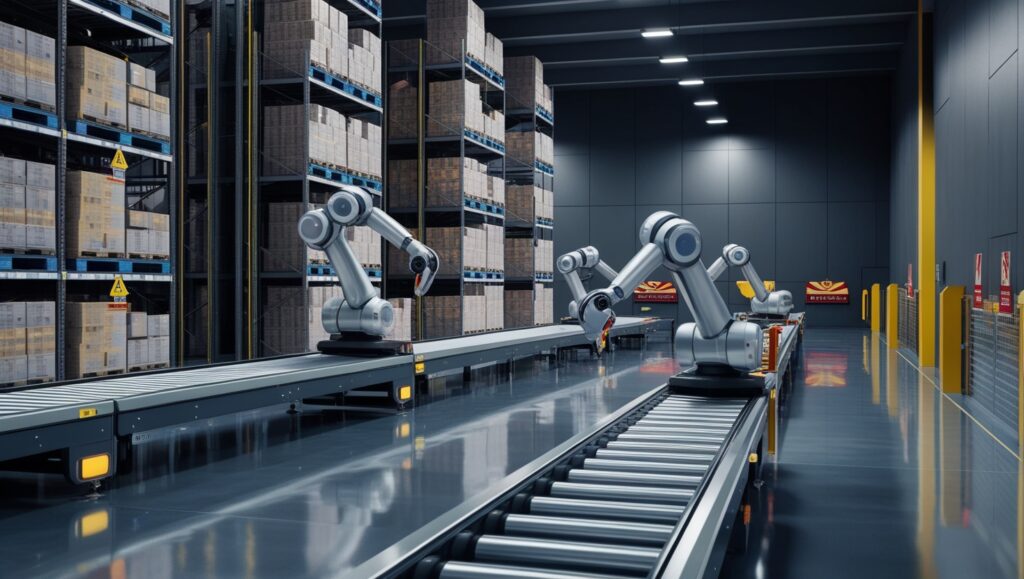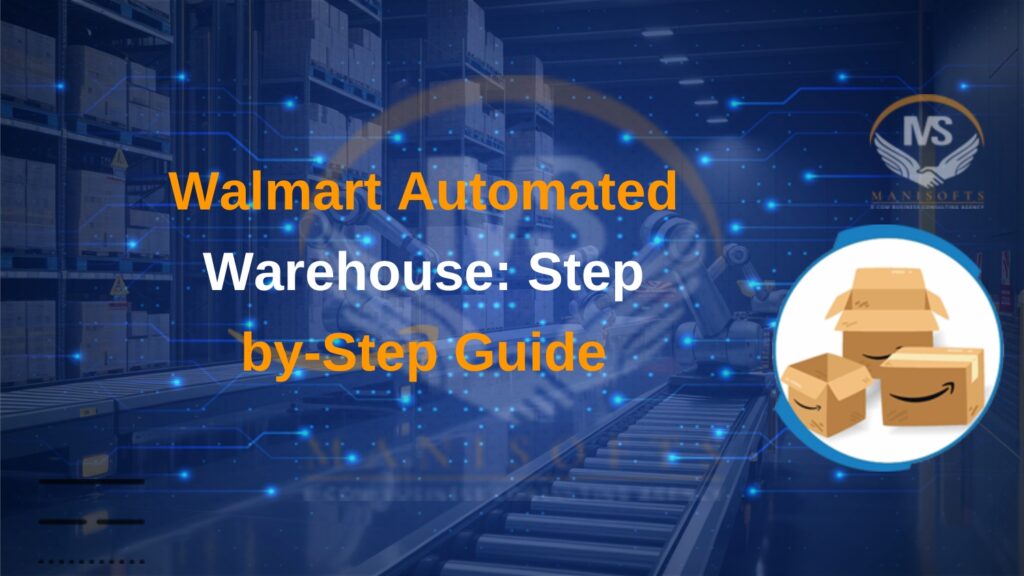Check out this in-depth tutorial on just how Walmart automated warehouses function, including robotic methods and AI storage. Read about the application of automation in terms of time reliability, accuracy, and increasing the scale of operations in the retail industry’s supply chain.
Introduction
Suppose you are in a higgledy-piggledy store full of small and big shelves, and small and big, noiseless robots with fantastic speeds ranging from top to bottom shelves, with equivalent speed as drivers pick and pack the orders. This is not something we have seen in The Matrix and other sci-fi movies – this is the real thing, and it is happening within Walmart’s automated depots. Only last month, a Whole Foods distribution center with Walmart had enhanced their order fulfillment speed by 30 percent while also decreasing picking mistakes by 50 percent from new automation efforts. These changes not only increase efficiency but also recast the very nature of the current retail environment.
Walmart automated warehouse
Currently, Walmart is at the forefront of retail advancement by using robotic stores that constitute a part of the company’s supply chain efficiency plan. Technology is thus applied at Walmart’s contemporary distribution centers; timely inventory management is enhanced through the technologies of Autonomous Mobile Robots (AMRs) and Automated Storage and Retrieval Systems (ASRS). These robots perform errands such as transferring products and sorting products, greatly enhancing the efficiency of the operations. This has also helped ease the workload on workers, space utilization and real-time stock control. Because Walmart has increased its number of automated distribution centers, the company can easily fulfill the demand during the holidays and other seasons with similar high sales rates. By doing so, Walmart is establishing an entirely new standard of retail efficiency and, of course, economies of scale.
The Power of Automation
Technological advancement is now the driving force of most industries, especially supply chains, whereby different organizations are forced to meet new demands of customers in terms of efficiency and quality. Being a colossal retail store inworldwide, Walmart has considered automation a highly transformative technology. However, the advantages have been witnessed to go way beyond Walmart, especially with the increased innovation and implementation of automation solutions. Large international corporations and organizations and small business ventures are using automation in business sectors to improve their supply chain processes, minimize expenses, and increase customer value.
Technology at the Forefront: The Tools of the Trade
Robotics and Autonomous Mobile Robots (AMRs)
Robotics and Autonomous Mobile Robots (AMRs) are central to Walmart’s automated warehouses. These flexible robots move around constrained warehouse spaces and perform pick-and-place duties with the least supervision. For instance, Walmart uses AMRs to manage big lifting tasks to partially ease their employees’ workload and enhance the stock flow. These are equipped with various sensors and navigation methods, making it easier for robots and human workers to share a workplace.
Artificial Intelligence (AI) and Machine Learning
AI and, in particular, machine learning are indispensable in improving the organization of warehouses and storage facilities. Thus, with data analysis, AI systems can anticipate demand patterns, order products efficiently, and integrate inventory management into supply chains. For instance, Walmart deploys AI in demand prediction to ensure that it has many stocks of what customers want most but does not have many of what customers wish to least. Also, machine learning supports decisions by improving the system’s functionality based on the incoming data in real-time.
Automated Storage and Retrieval Systems (ASRS)
Automated Storage and Retrieval Systems (ASRS) are revolutionizing warehouses’ inventory management. These systems consist of automated racks, conveyors, and retrieval machinery that work in unison to store and retrieve products with unparalleled efficiency. Walmart’s ASRS allows for dense storage configurations, significantly increasing the warehouse’s capacity. Moreover, ASRS minimizes the time required to locate and retrieve items, leading to faster order fulfillment and reduced operational costs.
The Internet of Things (IoT) and Sensors
Data connectivity of IoT devices and sensors is the other aspect of Walmart’s automation framework. These devices are integrated into the warehouse with a constant sampling of several factors about the warehouse, including temperature, humidity, and even inventory levels. Such real-time data is useful for controlling and improving processes so that conditions are favorable for storing various products. Further, with the use of IoT sensors, equipment requires less regular maintenance since problems that may otherwise cause equipment failure are indicated well in advance.
The Benefits: A Game-Changer for Walmart
Efficiency and Productivity
Technology has done a lot to help Walmart by increasing its legitimacy and capacity – in other words, its efficiency. For example, automated systems do not allow the employee to get tired, which results in continuous production. Consequently, it has been possible for Walmart to register a twenty percent general warehouse output and achieve a thirty-five percent improvement in the time taken to process orders. These improvements make it easy for Walmart to satisfy high customer expectations with relative ease.
Accuracy and Reduced Errors
A common advantage of automation is that it greatly minimizes general errors. Some of the organization’s business processes, such as the storage of inventory and orders, are automated to reduce human factors. Despite the great progress of Walmart’s distributed automated warehouses, its error rate is below 1 %, while the industry’s average is 3- 5 %. This precision means that the customer gets the right products on time, a factor that improves their shopping experience.
Safety and Reduced Risks
A common advantage of automation is that it greatly minimizes general errors. Some of the organization’s business processes, such as the storage of inventory and orders, are automated to reduce human factors. Despite the great progress of Walmart’s distributed automated warehouses, its error rate is below 1 %, while the industry’s average is 3- 5 %. This precision means that the customer gets the right products on time, a factor that improves their shopping experience.
Cost Savings and Optimization
It is a proven fact that the expense of introducing automation is rather high as compared to the expenditure to be incurred in the long run. Some of the benefits that Walmart might have achieved, therefore, include cutting costs on labor, minimizing errors as well as resultant wastage of stock. For instance, the time to receive a return on investment (ROI) out of automation at Walmart has been estimated to be three to five years due to the continuous operational efficiencies and cost reduction.
Scalability and Adaptability
Automation allows Walmart to scale operations in response to fluctuating demands. Whether during peak shopping seasons or sudden surges in product demand, automated systems can quickly adjust to maintain smooth operations. This adaptability ensures that Walmart remains resilient and responsive in a dynamic retail landscape.
The Challenges: Overcoming Hurdles

Initial Investment
When automation is applied to Walmart’s scale, this must mean that some serious levels of capital investment must be incurred at the start. Among the costs are related to the purchase of new high-end robotic systems, the design of the multiple layers necessary software systems, and the introduction of new robotic technologies to the existing structures. However, in Walmart’s case, this investment is considered strategic; an organization is willing to put down resources with the anticipation of paying big in the long run in terms of efficiency, costs, and customers.
Job Displacement
With automation comes the idea of eliminating human labor. Some of the traditional and often tedious tasks are assigned to the robots, while the nature of jobs in the warehouse changes with time. Nevertheless, Walmart is addressing this challenge by training and reallocating its employee force. Employees are being trained and retrained to become able to effectively operate and oversee the technological solutions that the firm has adopted and remain useful to the company’s constantly changing processes.
Technical Challenges and Maintenance Requirements
Complex automation systems require technical considerations to be sustained. The effective functioning of robots, AI systems, and ASRS entail factors best addressed by specialized personnel and monitoring. On the maintenance front, Walmart has set up technical teams solely to attend to and follow up on the maintenance and to attend to any incidents, so that automated warehouses are not brought to a standstill.
Cybersecurity and Data Privacy Concerns
Frequent utilization of closely connected systems makes cybersecurity a rather important issue. Information security and protection against cyber risks are critical for Walmart. The firm uses strong security measures such as encryption, firewalls, and other security features and security audits on all the developed automated systems and the data managed by the systems.
Success Stories and Lessons Learned
Walmart’s Implementation: Case Studies
The issue of automated warehouses has been successfully adopted and implemented by several companies, notably Walmart in Bentonville, Arkansas. This innovative engineering uses advanced mobile robots, such as AMRs, automatic storage and retrieval systems (ASRS), and artificial intelligence inventory control systems. Overall, the actualizable goals of the warehouse have been met, where space has been doubled and order fulfillment time has been cut down by 40%. One such example is related to the automated distribution center at the hub of the software company located in Los Angeles, where IoT sensors have been integrated to achieve 25 percent energy efficiency and a major cut down on operating expenses.
Lessons Learned: Insights and Best Practices
From these implementations, Walmart has gleaned several key insights:
- Integration is Key: All these technologies can be easily linked to one another to ensure that they are running efficiently and that the goal of automation is achieved.
- Employee Training: This is important when moving to automated systems, as employee training must be prioritized.
- Continuous Improvement: This is because consistent evaluation and optimization of such procedures entails long-term improvements and flexibility in operations.
- Data-Driven Decisions: Using data and analytics enables decision-makers to address challenges early enough and in the right manner.
Correctly on with Other Retailers
Relative to other large-scale merchants, Walmart is rather unique in its lift-and-dock-type strategy regarding automation. Other corporations, such as Amazon, have also aggressively invested in Robotics and AI. However, the fact that Walmart has focused on incorporating such technologies in large-scale existing operations provides a testament to the intent of the company. Also, Walmart’s robotic automated warehouses show that the company associates itself more with sustainability and efficient energy utilization than its counterparts.
The Future of Automation: A Glimpse Ahead
Emerging Technologies
Warehouse automation will continue to be even more revolutionary as more technologies form in the coming years. For instance, drones may suggest a radical shift to how companies track inventory by offering a bird’s eye view of stock levels and enabling faster stock-taking. Cobots, or collaborative robots, are intended to interact with employees during production processes to increase efficiency at the same level as minimization of risks and maximal freedom.
Potential Advancements
There is a demonstration that with the prospects of automation, it will become more intelligent and self-sufficient. AI and machine learning will enhance the ability of a system to learn needs, respond to disruptions and manage processes autonomously as much as possible. However, blockchain technology could also benefit the supply chain through increased efficiency, transparency, and security.
Impact on the Broader Retail Industry
Automation trends will keep emerging and enhancing technologies as the new yardsticks of retail performance. Key retail players who embrace high-end automation technology will probably capture the market by delivering goods faster and managing stocks efficiently while making the purchase experience more enjoyable. Furthermore, the availability of automation tools will impact large stores and retailers by making the field competitive and innovative.
FAQ’s
What is Walmart’s automated warehouse initiative?
Walmart’s select robotic automation project aims for a rapid, error-free supply chain and combines robotic intelligence, AI and ASRS at the carrier points of their distribution centers.
What technologies does Walmart use in its automated warehouses?
The technologies adopted by Walmart include AMRs for towing carts, ASRS for locating required products, AI for enabling proper processes and anticipating demand and IoT sensors that collect and transmit data.
How does automation improve efficiency in Walmart’s warehouses?
There is a massive improvement in efficiency with the application of automation in areas like order picking, inventory, and product sorting. Fixed systems operate twenty-four hours a day without needing a rest, thereby minimizing the time agreed to process various orders and eradicating human factors in handling many orders in a single day.
What are the benefits of automation for Walmart’s employees?
Automating the handling of tedious and strenuous tasks minimizes physical effort, thus increasing employee safety measures and directing them to perform more complex chores. Although it provides new opportunities for workers to monitor and service the system, it also opens up new opportunities for them to manage the automatons.
What challenges does Walmart face in automating its warehouses?
Some common issues include the expensive costs of automation technologies, the transition of employees to new positions to care for new systems, constant maintenance systems, and the problem of securing the information created by these automated processes from hackers.
Conclusion
Walmart’s foray into automated warehousing exemplifies the profound impact of robotics and advanced technologies on retail operations. By embracing automation, Walmart has enhanced its efficiency and productivity and set a benchmark for the industry. As technology continues to evolve, the robotic revolution in warehousing will likely accelerate, driving further innovations and shaping the future of retail. For Walmart and other forward-thinking companies, the journey toward fully automated supply chains promises a future of unparalleled growth, sustainability, and customer satisfaction.




